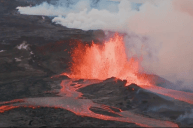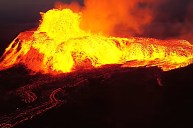Scientists fear that a North American volcano may soon erupt. It would be the first time that it has erupted since 1992. Researchers say the volcano appears to be "moving closer to an eruption."
Located in Alaska, Mount Spurr sits just 81 miles away from Anchorage. It's a fairly large chunk of rock, measured at 11,000 feet tall. In Early March, researchers observed elevated levels being released at the summit. It's the latest development for Mount Spurr, which has been showing activity since last April.
Last year, researchers observed several small earthquakes near the volcano. Activity has increased since then. Now, researchers are saying that Mount Spurr could blow in just "weeks or months." They theorize that the volcano would blow through its Crater Peak side vent.
On March 7, Mount Spurr, an 11,000-foot-tall stratovolcano that sits 81 miles west of Anchorage, began releasing elevated levels of gas from its summit and a side vent that last erupted in 1992.
These emissions are the latest development in a period of unrest this volcano has been experiencing since April 2024, when it started shuddering with small earthquakes — the first clue that new magma was rising toward the volcano's vents. Matt Haney, scientist-in-charge at the Alaska Volcano Observatory (AVO) at US Geological Survey (USGS) spoke to Daily Mail about the impending eruption.
Volcano Eruption
When Mount Spurr erupts, it would last anywhere from three to four hours, spewing ash 50,000 feet high. The immediate concern is for Anchorage and surrounding areas. Ash could blanket the atmosphere proving to be a hazard. The volcano could also cause mudslides closer to the mountain. However, Haney said, "But fortunately, there are not any communities in that radius that would be affected."
Haney also added, "We have been tracking this for about a year." It would be the first time that Mount Spurr erupted since 1992. Prior to that, it also erupted in 1953 as well. Both of these were from its side vent. As far as its main vent is concerned, scientists estimate that it has blown in 5,000 years.
"With the new measurement of gas emissions above backgrounds, that led us to conclude that an eruption like the two recent ones was the most likely scenario," Haney said.
It seems that the volcano has undergone periods of decades of dormancy. Almost 40 years stretched from 1953 to 1992 between eruptions. Now, a similar time frame appears again. However, despite signs pointing to eruption, scientists are unable to say exactly when the volcano may blow.




